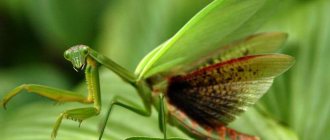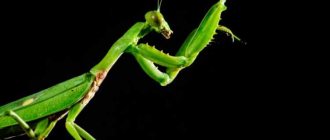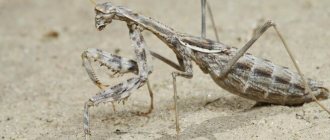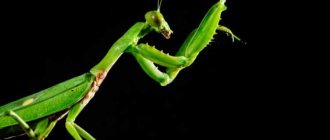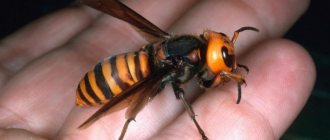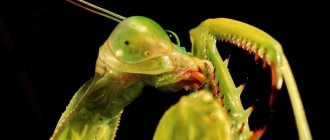Arthropod insects from the order Praying Mantises received their Russian name due to the fact that their forelimbs are similar to human arms, bent in the hands.
While in ambush, they take a wait-and-see attitude. In the photo of praying mantises you can see this behavioral feature. This posture is associated with the position of the body of a person reading a prayer.
What it looks like: structure and characteristics of a praying mantis
Structure of a praying mantis
As a rule, praying mantises have an elongated body, which is a distinctive feature of these insects. Praying mantises are one of the few insects that can make a full rotation of their head around its axis . This is why they can easily spot enemies from behind. The insect has only one ear, but its hearing is excellent.
Mantis eyes
Mantises have compound eyes that are located on both sides of the head.
There are also three elemental eyes above where the antennae grow. The mantis' mustache, in turn, has a comb structure and can also be feathery and filamentous. The type of whiskers varies depending on the type of insect. Interesting fact : praying mantis is one of the varieties of wushu.
According to Chinese beliefs, this style was invented by a peasant who had been watching mantises hunt for a long time. Most varieties of mantises are equipped with wings, but only males can use them for their intended purpose. Females are unable to fly due to their large size and weight. Each insect has two pairs of wings - front and rear. They are usually brightly colored, sometimes with beautiful patterned designs. However, there is one species of mantis that has no wings at all - the ground mantis.
Mantis - structure and characteristics
Each mantis is well built and has developed front legs with which it can grab prey. The structure of the forelimbs is as follows: acetabular rings, femurs, tibiae with hooks at the ends, and paws. There are sharp spines on the lower part of the thighs, and there are also smaller spines on the lower leg.
Mantises clamp the caught food between their legs and thighs. They hold it until they eat it completely. Due to their unusual respiratory apparatus, praying mantises have the simplest circulatory system. Oxygen enters the insect's body through a complex chain of several tracheas, which are interconnected by stigmata.
Nutrition
It is no secret that our hero is a notorious predator who loves to feed on both smaller insects and is not afraid to attack larger prey even than himself. Flies eat them,
mosquitoes, bees, wasps, bumblebees, butterflies, beetles, etc. Large representatives of the praying mantis family (see above) can even attack small rodents, birds and small amphibians: frogs, lizards.
Mantises usually attack from an ambush, unexpectedly grab the prey with their front paws and do not let go until they have completely eaten it. Strong jaws allow these gluttons to eat even relatively large prey.
Dimensions
Ischnomantis gigas
The most important difference between the sexes is size. Females are much larger than males. The largest species of mantis, Ischnomantis gigas, lives in Africa; it can grow up to 17 cm in length, holding the record for its size among all mantises.
The second longest species of mantis is Heterochaeta orientalis. The record sizes of these representatives of mantises are slightly smaller - up to 16 cm. The simplest representatives of the species grow no more than 1.5 cm in length.
Interesting fact : in the USSR there was a plan according to which mantises could be used as protectors against agricultural pests. However, the idea was not realized, as predators killed the bees.
Rhombodera basalis
A large praying mantis from the genus Rhombodera can be found among the tropical forests of India, Thailand and Malaysia. Prefers to settle in humid and warm places. Adults grow up to 9 cm.
It differs from other species in its chest shield. The color is turquoise-green with a blue tint. Because of its beauty and calm disposition, it often becomes a resident of home aquariums.
Habitat - where does the praying mantis live?
Habitat of the praying
mantis Mantises are distributed throughout the planet. They are in Europe, Asia, Africa and America. A wide variety of mantises have been recorded in Asian countries. A few species can be found in the CIS countries. Insects were also brought to Australia and North America, where they were able to take root.
Interesting: Wolverine
